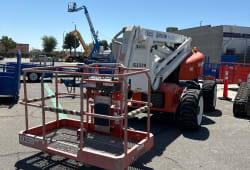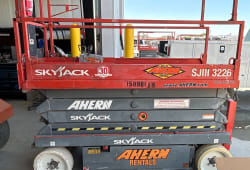Essential Guide to Buying Used Cranes: Tips and Considerations
6 Lectura mínima
)
marzo 7, 2024
Introduction to Cranes
Cranes are essential equipment in construction, manufacturing, and various industrial sectors. They are used for lifting, lowering, and moving heavy materials and objects with ease and precision.
Types of Cranes
Mobile Cranes
Mobile cranes are versatile lifting machines known for their mobility and adaptability to various job sites. These cranes feature a telescopic boom mounted on a mobile platform, such as a truck or crawler, allowing them to move easily across different terrains. They are ideal for construction projects, infrastructure development, and industrial applications where frequent relocation is required. Mobile cranes come in various configurations, including hydraulic cranes, rough terrain cranes, and truck-mounted cranes, each offering specific advantages in terms of lifting capacity, reach, and maneuverability.
Tower Cranes
:format(webp))
Tower cranes are iconic structures commonly seen on construction sites, towering over buildings under construction with their imposing height and reach. These cranes are fixed to the ground and have a vertical mast with a horizontal jib extending outward. Tower cranes are renowned for their ability to lift heavy loads to great heights and cover a wide radius, making them indispensable in high-rise construction projects. They are equipped with advanced control systems and safety features to ensure precise operation and minimize the risk of accidents.
Overhead Cranes
Overhead cranes, also known as bridge cranes or gantry cranes, are commonly used in industrial facilities, warehouses, and manufacturing plants for lifting and moving heavy loads within the workspace. These cranes are mounted on elevated runways or beams that span the length of the building, allowing them to traverse back and forth along the overhead track. Overhead cranes come in various configurations, including single-girder and double-girder designs, each offering different lifting capacities and operating speeds. They are equipped with lifting mechanisms such as hoists and trolleys to facilitate efficient material handling and streamline production processes.
Rough Terrain Cranes
Rough terrain cranes are rugged and robust machines designed for off-road construction sites and challenging working environments where the terrain may be uneven or inaccessible to conventional cranes. These cranes are equipped with heavy-duty tires, sturdy outriggers, and a durable chassis to provide stability and maneuverability on rough terrain. They feature telescopic booms that can extend to significant heights and lift heavy loads with precision and control. Rough terrain cranes are commonly used in infrastructure projects, oil and gas exploration, and mining operations where traditional cranes may struggle to operate effectively.
Crawler Cranes
Crawler cranes are powerful lifting machines equipped with tracks or crawlers instead of wheels, allowing them to navigate through challenging terrain and maintain stability while lifting heavy loads. These cranes are often used in construction projects, bridge building, and foundation work where mobility and lifting capacity are critical. Crawler cranes feature a lattice boom or telescopic boom that can be extended to considerable heights, making them suitable for lifting tasks in confined spaces or at great heights. They are known for their versatility, durability, and ability to handle complex lifting operations with ease.
Applications of Cranes
Cranes are used in various industries, including construction, manufacturing, shipping, and logistics. They play a crucial role in lifting heavy materials such as steel beams, concrete panels, and machinery.
Buying Used Cranes
Advantages of Buying Used Cranes
Cost-effectiveness: Used cranes are often available at a fraction of the cost of new ones.
Immediate availability: Buying used cranes allows for quicker deployment on the job site.
Established performance: Many used cranes have a proven track record of reliability and performance.
Considerations Before Purchasing
Age and condition: Assess the age and overall condition of the crane to determine its remaining lifespan and maintenance needs.
Service history: Review the crane's maintenance records and any past repairs or upgrades.
Compatibility: Ensure that the crane meets the specific requirements of your project in terms of lifting capacity and reach.
Inspection and Maintenance Tips
Thorough inspection: Conduct a comprehensive inspection of the crane's structural components, mechanical systems, and safety features.
Regular maintenance: Implement a regular maintenance schedule to keep the crane in optimal working condition and prevent breakdowns.
Finding Reliable Sellers
When buying used cranes, it's essential to source them from reputable sellers or dealers with a track record of honesty and integrity. Look for sellers who offer transparent pricing, detailed product information, and excellent customer service.
Pricing and Negotiation
Compare prices from multiple sellers to ensure that you're getting the best value for your money. Don't hesitate to negotiate with sellers to achieve a fair deal that meets your budget and requirements.
Financing Options
Explore financing options such as loans, leases, or rental-purchase agreements to spread out the cost of purchasing a crane over time. Consider factors such as interest rates, down payments, and repayment terms when choosing a financing option.
Delivery and Installation
Coordinate with the seller to arrange for the delivery and installation of the crane at your job site. Ensure that the crane is transported safely and installed correctly to prevent accidents or damage.
Safety Measures
Implement strict safety protocols and procedures when operating cranes to minimize the risk of accidents or injuries. Provide training for crane operators and maintenance personnel on safe handling practices and emergency procedures.
Environmental Impact
Consider the environmental impact of using cranes and implement measures to minimize pollution, noise, and disruption to the surrounding ecosystem. Use eco-friendly lubricants, fuels, and materials whenever possible to reduce carbon emissions and environmental footprint.
Conclusion
In conclusion, cranes are indispensable equipment in various industries, facilitating the lifting and movement of heavy materials with efficiency and precision. When buying used cranes, it's essential to consider factors such as condition, reliability, and compatibility to ensure optimal performance and safety on the job site.
FAQs
Are used cranes as reliable as new ones?
Yes, many used cranes have a proven track record of reliability and performance, making them a cost-effective option for many buyers.
How can I ensure that the used crane I'm buying is in good condition?
Conduct a thorough inspection of the crane's structural components, mechanical systems, and safety features, and review its maintenance records and service history.
What financing options are available for purchasing a used crane?
Financing options may include loans, leases, or rental-purchase agreements, depending on your financial situation and preferences.
How do I ensure the safe operation of a crane on my job site?
Implement strict safety protocols and procedures, provide training for crane operators and maintenance personnel, and adhere to industry safety standards and regulations.
What environmental considerations should I keep in mind when using cranes?
Minimize pollution, noise, and disruption to the surrounding ecosystem by using eco-friendly lubricants, fuels, and materials, and implementing measures to reduce carbon emissions and environmental footprint.

Caleb Woods is an experienced content specialist and an editor at Boom & Bucket, blending his journalism background with expertise in the heavy equipment industry. He delivers engaging, informative content to help professionals stay informed and make smarter decisions in the machinery market.











